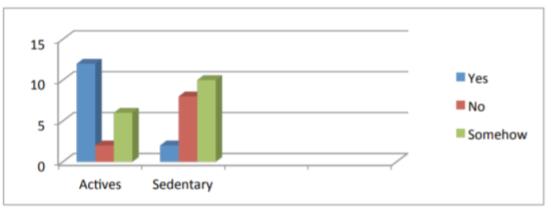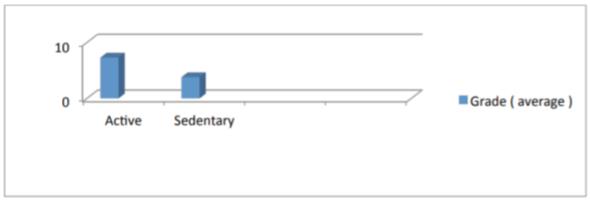Abstract
During almost 30 years of experience in teaching physical education and sport, I understand that precisely the uniqueness, complexity of human nature can provide the correct answers to questions related to culture, perception, habits, etc. The purpose of the paper: Determination of amounts that resulted in the case of students in developing a positive attitude - active against motor activities, and other students caused a negative attitude - passive. Hypothesis work: Finding these elements can contribute to the development of teaching strategies that emphasize positive stimuli / improve on the negative, so that students participate consciously, actively, systematically practicing the exercise and after graduation. During two years of study, we initiated an active observation of the degree of involvement of student participation in physical education classes and sports provided in the curriculum of the Faculty of Mechanics and Technology, University of Pitesti. Following this approach we selected 20 students with a strong intrinsic motivation and 20 extrinsic predominant motivation for driving activities. These 40 students have completed the end of the second an opinion survey questions focusing on the practice of physical exercises (in various forms), family, school, material conditions, the subjective perception of reactions (physical and mental) of their own body to exercise. Physical education in higher education, it is, as I like it define,, last redoubt "that the teacher must have a win for the stadium, on the mountain, in gyms or swimming pools, etc. to meet his former students, friends, family, moving.
Keywords: Motive activitiespositive - active attitude/ negative – passive attitudestudents
Introduction
During nearly 30 years of experience in teaching physical education and sport, I understood that
precisely the uniqueness, complexity of human nature can provide the best answers to questions related to
culture, perception, habits, skills, education and so on. Forming healthy habits are important objectives
for those who educate, for society, for each and every person, by Popescu (2016) the three directions in
where formative valences of handball or other games or motive activities manifest itself and taught in
school are : recreational-fun, compensatory, neuro-psychomotive rehabilitation, formative on personality
and character.
Besides entertaining activities of the game, the gymnastics and agonistic ones are added to the
basic content of school`s physical education, all contributing to the consolidation of an habitude of
practicing a physical exercise beneath various forms (Epuran, 2013).
Leisure area is certainly one of the most dynamic areas, marking a rise lately in the unprecedented
offers to practice the exercise (Moldovan, 2007).
Developing this idea, we can add that `taking into consideration the value of physical activity for
people of all ages (personal and social benefits) a great priority should be granted to increasing
motivation and opportunities of practicing physical exercises, safely and to an acceptable cost, conditions
without these multilateral potential of physical activity could not be exploited` and in terms of permanent
education `should be understood as a permanent conviction for the entire educational process, with a
paradigmatic character` by Stancu (2015).
A recent Chronicle Herald article (Tierney, May 21, 2011) describes the research of Dr. Martin
Seligman and identifies factors he views as critical to well-being: positive emotion, engagement,
relationships, meaning, and accomplishment, http://www.recreationns.ns.ca/wp-
content/uploadhere/2012/05/MentalHealthLit.pdf.
The Aim of this Paperwork
Determining factors that have contributed to a positive - active attitude for some students and
promoting them within classes, and also those who have contributed to a negative – passive attitude and
avoiding using them during classes.
The Hypothesis of this Paperwork
As better stimulating factors of a positive-active attitude will be known and promoted during the
instructive – educational learning processes as much practitioners of motive leisure activities will there
exist.
Subjects : 500 students, aged between 19-24 years old.
Methods used : As they intervened in the comparative study performed the methods are the
following ones : observation, scientific documentation, questionnaire survey, statistical and graphical
method.
Work Methodology
During two years of study, I have initiated an active observation of the way students are
participating and getting involved in physical education classes and sports provided in the curriculum of
the Faculty of Mechanics and Technology, University of Pitesti.
Each attendance received a code (1, 2 ,3), signifying:
Presence at class as exempted student, without sports equipment, minimal involvement in their activity. This code that can occur only one time during a semester;
Minimum attendances for being able to take the final exam;
Active participation to all classes, even in addition with other groups or taking part in
competitions between faculties organized at UPIT.
After this active observation I have selected 20 students with a strong intrinsic motivation and
other 20 students with a predominant extrinsic for motive activities. These 40 students have completed at
the end of the second year of studies an opinion survey. The questions were about practicing physical
exercises (in various forms) among side family or at school, material status, the subjective perception of
reactions (physical and mental) of their own body to physical exercises, accommodation, the necessity for
practicing sports.
Results
Responses were then analyzed, processed and interpreted as follows:
1. For the first question: `Do you consider yourself a dynamic person?`, the answers are the
following ones:

2. For the second question: `How much of your free time is dedicated to the following activities?` the
answers were :

3. Question number 3 checks students' perception on the responsibility of certain factors in the
formation of healthy habits. The results showed that students from both groups assign percentages, almost
alike to school, then family and on the third place to friends and other institutions.

4. Regarding question No. 4, students' responses indicates a different perception on the influence of
certain persons in helping them to appreciate sports. Thus, the sports teacher is assigned with a percentage
of 50% of sports lovers and only a percentage of 22% from the others.

5; When asked to assess the quality of physical education and sports classes in pre university
education, the first group have an average rating of 7.3, while the second one, a percentage of 3.8.

6. Since absenteeism from physical education classes and sports is a major cause of the fact that
such a skill can not be formed, students who are active are not really missing classes (only 10%), while
the others are absent in a percentage of 35 %.
7. Which of the following arguments would make you practice even more sport activities (if you
are an active person) / or will make you start practicing a sport you like most (in case you are a
sedentary), was the last question that students responded.
The analysis of these answers showed that students who practice motive activities in their leisure
time complain less about lack of time, in a percentage of 10% and have no health problems - 0%. On the
other hand they feel the need for more sport facilities – 50% and more money for equipment in a
percentage of 40%.
Students who practice much less motive activities in their leisure time, they also want more money
for equipment - 25%, and more sport facilities - 25% but complain about health problems - 20%, and
about the lack of time - 30%.
Conclusions
-
We note that students who perceive active allocate 31% of their free time practicing physical exercises.
-
As might be expected, they are the ones who miss gym classes.
-
As private role of institutions, school is assigned the responsibility of forming healthy habits.
-
Among those with responsibility in shaping taste for movement, sports teacher is assigned (50%) of cases.
-
The two key words: school - professor remain crucial elements in building and strengthening the healthy habits.
-
Physical education in universities, is, as I like to define: `the last redoubt` a teacher must win in
-
order to make people go hiking, at stadiums, to gyms or swimming pools among side their friends and
-
families. The satisfaction is even bigger when you succeed, especially when those people considered
-
themselves sedentary persons.
References
- Epuran, M. (2013), Motricity and psychism in body related activities. Introduction to a meta-theory of body related activities. Entertaining. Gymnastics. Agonistic. Recreational. Compensatory. Volume nr.1, FEST publisher.
- Moldovan, E. (2007) - Relevant aspects of psychosocial outdoor education activities in the education of young people, National Scientific Conference, Bucharest, 245.
- Popescu, D. C. (2016), Handball in school - theoretical course, Pitesti: University of Pitesti.
- Stancu M. (2015), Women and motivation of practicing corporal leisure, Pitesti: University of Pitesti. http://www.recreationns.ns.ca/wp content/uploadhere/2012/05/MentalHealthLit.pdf
Copyright information

This work is licensed under a Creative Commons Attribution-NonCommercial-NoDerivatives 4.0 International License.
About this article
Publication Date
25 May 2017
Article Doi
eBook ISBN
978-1-80296-022-8
Publisher
Future Academy
Volume
23
Print ISBN (optional)
-
Edition Number
1st Edition
Pages
1-2032
Subjects
Educational strategies, educational policy, organization of education, management of education, teacher, teacher training
Cite this article as:
Stancu, M. (2017). Study On The Main Elements Which Determine Students To Practice Motion Activities. In E. Soare, & C. Langa (Eds.), Education Facing Contemporary World Issues, vol 23. European Proceedings of Social and Behavioural Sciences (pp. 1520-1525). Future Academy. https://doi.org/10.15405/epsbs.2017.05.02.187

